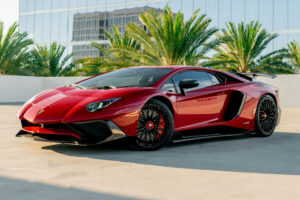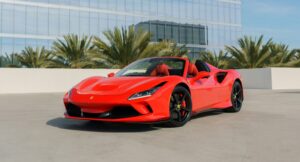Maserati S.p.A. is a paragon of Italian luxury vehicle manufacturing. The company’s roots began on December 1, 1914, in Bologna by Alfieri Maserati and his brothers. The company’s saga began with a focus on designing and building race cars.
Today, Maserati’s headquarters are located in Modena, Italy. The emblem of Maserati, a striking trident, is a nod to the Neptune Fountain in Bologna, representing strength and vigor.
The transition from Maserati’s early racing heritage to producing luxurious road cars marked the brand’s expansion into broader markets. Emphasizing elegance, performance, and exclusivity, Maserati’s vehicles have become symbols of status and refinement. Ownership of the company has changed hands several times throughout its history.
The most recent transition was in 2021, when it became a part of the multi-national conglomerate Stellantis.
Maserati’s legacy is not only etched in its past but also alive in its continual push towards innovation. The company has embraced new technologies and designs, ensuring that each vehicle upholds Maserati’s reputation for creating automobiles that excel in luxury and performance. While maintaining a firm grip on its Italian heritage, Maserati also keeps an eye on the future.
This is evidenced by its ongoing commitment to electrification and global expansion within the luxury automotive segment.
Origins and Founding
Maserati’s storied history began over a century ago, rooted in the passion for automotive engineering and a symbol that would become synonymous with luxury and performance.
The Maserati Brothers
Alfieri Maserati, alongside his brothers Ettore and Ernesto, laid the foundation for what would become one of Italy’s most iconic automobile manufacturers. It all started in Bologna, Italy, where Officine Alfieri Maserati was established on December 1, 1914. These brothers were gifted engineers and entrepreneurs, driven by a shared fascination for automobiles and the mechanisms that powered them.
Early Ventures and the Birth of the Trident
Before Maserati became known for its luxurious and high-performance cars, its initial foray was producing spark plugs. This was when World War I gripped Italy, and industrial innovation was directed towards the war effort.
Post-war, the brothers transitioned from industrial products to creating race cars, notably after separating from Diatto, a car manufacturer for whom they had previously designed race cars. This significant move marked the true beginning of the Maserati marque.
The adoption of the Trident further reinforced the brand’s identity as its emblem—a design inspired by the Fountain of Neptune in Bologna, symbolizing strength and vigor.
Rise to Racing Prominence
Maserati’s ascent in the racing world is marked by significant victories and the creation of iconic models that dominated the track. Their innovative engineering and design propelled Maserati to a formidable position in motorsports history.
Notable Victories and Maserati in Motorsports
Maserati’s foray into motorsports led to notable victories that underscored their engineering prowess. In the 1920s, the Tipo 26, Maserati’s first race car, succeeded in the 1926 Targa Florio, signaling the brand’s potential in competitive racing. This victory was a precursor to a legacy of triumphs across different racing events.
One of the most significant figures associated with Maserati’s racing success is Juan Manuel Fangio, who is synonymous with motorsport excellence. Fangio’s skill behind the wheel of Maserati vehicles helped the marque secure wins in several Grand Prix and World Championship races. His feats include winning the Formula One World Championship in 1957 and driving the Maserati 250F, which solidified his and the manufacturer’s legendary statuses.
In addition to circuit racing, Maserati’s reach extended to iconic American races like the Indianapolis 500. Maserati cars displayed their versatility and high performance by securing victories, showcasing the brand’s ability to compete and win on varied international stages.
Iconic Maserati Racing Models
The racing heritage of Maserati is characterized by the creation of some of the most iconic models in motorsport history. Key models that have etched their names in the annals of racing include:
- Maserati 250F: The epitome of a racing car in the 1950s, this model is renowned for its advanced technological features and sleek, aerodynamic design. It represented Maserati’s dominance during Grand Prix races.
- Maserati Tipo 60/61 “Birdcage”: Famous for its intricate and lightweight space frame chassis, this model not only stands out for innovation but also for its performance and wins, such as those in the grueling endurance race, the Targa Florio.
Maserati’s commitment to engineering and aeronautics is evident in the race cars that have raised the bar in motorsport competitions. Each model reflected inventive design and sheer power, solidifying Maserati’s race-winning reputation.
Pivotal Models and Automotive Innovation
Maserati’s history in crafting pivotal models defines its stature in automotive innovation. The marque’s grand tourers and technological advancements have left indelible marks on the industry.
Road Cars and Grand Tourers
Maserati’s foray into road cars began with the 3500 GT in 1957, marking a significant evolution for the renowned brand for its racing pedigree. The 3500 GT was not just a pioneer in transitioning Maserati into a producer of road-going vehicles; it also established a new era for grand touring automobiles with its sophisticated blend of performance and luxury.
The introduction of the Ghibli in 1966 signified another landmark in Maserati’s lineage. Designed by Giorgetto Giugiaro and characterized by its shark-nose front end, the Ghibli garnered acclaim for its captivating aesthetics and potent V8 engine. The Quattroporte, an executive sedan that debuted in 1963, brought performance to the four-door sector, setting a precedent for future luxury sports sedans.
- Bora and Merak, unveiled in the 1970s, offered mid-engine designs that provided an exhilarating driving experience and pushed the bounds of innovation during their respective eras.
- The Mistral, featuring a body by Frua and named after a wind like other Maserati models, continued to emphasize the brand’s unique approach to designing grand tourers with a blend of elegance and sportiness.
Technological Advances and Engineering
Throughout its history, Maserati has been at the forefront of automotive engineering, with a drive towards using innovative technologies and engines. The 5000 GT, for instance, was a bespoke masterpiece powered by a 5-liter V8 engine, often referenced as a prime example of the brand’s engineering capabilities.
With its twin-turbocharged engines, the Biturbo was a radical move during the 1980s. Maserati boldly attempted to offer cutting-edge technology and superior performance in a more accessible package. Although the Biturbo faced challenges, it showcased Maserati’s commitment to innovation.
List of notable engines and their respective models:
- 3.5L Inline-6 (3500 GT, Mistral)
- 4.7L V8 (Ghibli, Quattroporte)
- V6 engines (Merak, Biturbo)
Design collaborations with prestigious coachbuilders like Vignale created class-leading grand tourers. The harmonious fusion of expert engineering and artistic design is a trademark that continues to distinguish Maserati from luxury automotive manufacturers.
Modern Era and Brand Evolution
Maserati has undergone significant changes in the modern era, including ownership transitions and technological advancements to stay abreast of market trends and environmental considerations.
Ownership Changes and Expansion
Fiat acquired Maserati in 1993, bringing it under the same umbrella as other prestigious brands like Alfa Romeo and Ferrari. This alignment led to synergies in technology and design.
Under the Fiat Group, Maserati expanded its product line with models such as the luxurious SUV, the Levante, and the sporty Grecale, bolstering its market presence.
In 2021, the conglomerate known as Fiat was part of a merger that created Stellantis, a global automotive powerhouse. Maserati benefited from this realignment, accessing broader resources for its expansion strategies.
Maserati in the Age of Electrification
Maserati’s strategy in recent years has included a significant shift towards electrification. This reflects the industry’s movement towards sustainability.
Models such as the MC20 signify Maserati’s commitment to combining high performance with eco-friendly technology.
The Partnership between Maserati and the larger entities of the group it is part of has facilitated technological advancements. These synergies ensure that Maserati is well-positioned to navigate the challenges and opportunities of an increasingly electric future, marking an exciting new chapter in its storied history.

